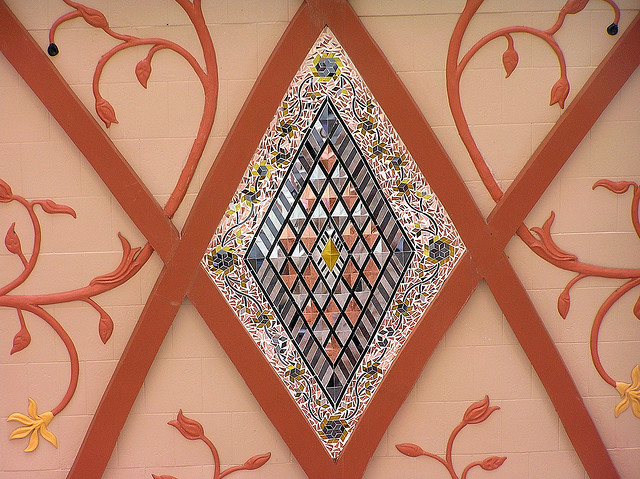Placed strategically at the center of Islamabad, elbowing the Zero Point Interchange, on the West viewpoint of the Shakarparian hills, spread over an area of 2.8 hectares, is situated the impressive National Monument of Pakistan, at an elevation of 1880 feet above sea level, bearing 33° 41’ N 73° 04’ E.
For about 60-years, there was no dedicated national monument in Pakistan. Since the inception of the country in 1947, the Minar-e-Pakistan, Lahore served as the self-proclaimed national monument. Minar-e-Pakistan has been closed for general public for the past thirteen years since it became the favourite spot for more than half of the depressed nation to climb up to and then plunge themselves in a free fall. While that was not the motive to build another suitable monument, what the nation was really lacking in terms of architectural form was a national art gallery and a national monument. In 1986, the Faisal Mosque in Islamabad, being the largest mosque in the world, once again served as a self-proclaimed national monument, but an official title was never given to either of the structures.
The idea to build a national monument was conceived by the Ministry of Culture and the Pakistan Council of Architects and Town Planners (PCATP) was entrusted to design a befitting structure to represent the aspirations of the people of Pakistan. The PCATP organized a national competition around the theme of signifying strength, unity and dedication of the people of Pakistan into an icon representing an independent and free nation.
From a total of twenty submissions, three were short-listed. Finally, the design proposed by Arif Masood was selected. The foundation stone was laid on May 25, 2004 and the complex was completed by the end of 2006, to be inaugurated on Pakistan Day, March 23, 2007. The total cost incurred was more than Rs.580 million (£43 million).
The monument has been constructed in a way that it looks like a blooming flower, with its four larger petals, built from granite, representing the four developing and progressing provinces of Pakistan – Baluchistan, Khyber Pakhtunkhawa, Punjab and Sindh; and the three smaller petals representing the three smaller territories of Northern Areas, Azad Kashmir and Federally Administered Tribal Areas. On the central platform, there is a crescent and a star surrounded by a water body, representing the crescent and star on the flag of Pakistan. The metallic crescent surrounding the star is inscribed with sayings of Muhammad Ali Jinnah (Founder of the Nation) and poetry of Allama Iqbal (National Poet). On the right side of the main structure, there are four gigantic pillars bearing torches atop, representing the cardinal slogans Unity, Faith, Discipline, of the Founder of the Nation, the Quaid-e-Azam (the Great Leader) Muhammad Ali Jinnah. The theme on the steps of the monument resembles flowing water that has made its path itself. At the frontal base of the monument, there is the monument museum that carries the history towards the independence of the nation, which also includes archived images and documents. At the back of the monument is a lotus-shaped observation deck that overlooks the twin cities of Islamabad and Rawalpindi, and provides a beautiful view of the Margalla Hills and the Himalayas.
There are numerous fountains at the monument and a lot of balconies jutting out at the boundaries on the western side of the secondary terrace with benches, and provide a panoramic view of the city of Rawalpindi.
The murals on the inside of the granite petals are inspired by Islamic architecture, and were decorated by a team of artists led by Kausar Jahan and Zarar Haider Babri. It took a total of 119,000 hours to complete the artwork of the monument. The petals carry artwork of the various landmarks, rituals and icons of the country. The first petal features the Malki Tombs, Shahjahan Mosque, Rohtas Fort, Gawadar, and Faisal Mosque. The second petal depicts the images of the Quiad-e-Azam Muhammad Ali Jinnah, his sister Fatima Jinnah, Minar-e-Pakistan, Badshahi Mosque, Shila Tunnel, Karakorum Highway and a group of cheering people at Jinnah's public appearance. The third petal reflects Allama Iqbal, the Shah Rukn-e-Alam's Tomb, Mahabat Khan Mosque, Indus Valley Civilization, Lahore Fort and Indus River Delta. The fourth petal comprises of the images of Sheesh Mehal in Lahore Fort, Shalamar Gardens, the Uch Sharif Tomb, Islamia College Peshawar, Ziarat Residency of the Quaid-e-Azam, the Khyber Pass and Shandoor Polo Festival.
The main courtyard of the monument contains glowing tiles, which provide a beautiful view at night when illuminated. The artwork on the main and secondary terraces of the monument is simply awe-inspiring. There is a large number of people deputed to the maintenance of the monument.
On Saturdays, there is a flag lowering ceremony by a smartly turned out contingent of Pakistan Army, Navy and Air Force and the mounted President's Body Guards. The sounding of the Retreat by the buglers atop the building of the Pakistan Monument Museum is an event to behold.
A view of the lotus-shaped observation deck.
The lotus-shaped observation deck provides a 270 degree view of the surroundings.
You can easily find 365 different ambiences of this place in a year.
The base of the monument is quite mysterious in looking. In actuality, there are hidden sanctums in there which serve as offices to the resident engineers.
A veiw from the base of the illuminated steps. The walls on the left and right carry the hand imprints of all the workers who contributed in the construction of the monument.










